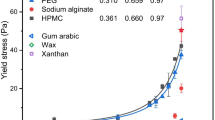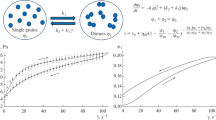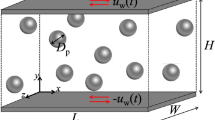Abstract
The rheological behaviour of Ca(OH)2 suspensions is investigated, predominantly at a solid volume fraction of 0.25. The influence of standing without being subject to shear (“contact time”) is distinguished from that of being sheared (“shearing time”). The results are interpreted on the basis of the “elastic floc” model of energy dissipation during flow, with a view to the problem whether, in addition to an energy dissipation term related to the viscous drag experienced by particles moving within flocs, there should be an independent energy dissipation term related to fluid movement in the flocs when they change volume or shape. It appears that this additional energy dissipation term is not necessary, if the increase in viscous friction, experienced by two particles which are close together, is taken into account.
Similar content being viewed by others
Abbreviations
- A :
-
average distance between shear planes
- A 1 :
-
average distance between shear planes for\(\dot \gamma \to \infty \)
- a :
-
radius of an aggregate
- c :
-
radius of sphere
- c v :
-
solid volume fraction
- E :
-
energy dissipation per unit of volume and time
- f :
-
average frictional coefficient (= quotient between actual friction and friction as calculated for an isolated sphere)
- f i :
-
frictional coefficient of particle or aggregatei
- f′ :
-
frictional coefficient describing the work required for moving two spheres towards or away from each other
- l :
-
fraction of distance traveled by an aggregate, over which it entrains its directly contacting neighbours (average value)
- n :
-
number of links between an aggregate within a domain, and an aggregate bordering a shear plane
- q :
-
average number of directly contacting neighbours of a particle or aggregate in a floc
- r :
-
distance between centers of two spheres or aggregates
- r 0 :
-
initial distance between centers of two spheres
- s :
-
r/c
- t c :
-
time during which Ca(OH)2 is in contact with water, without being sheared
- t r :
-
time during which a shear is applied
- t 1 :
-
time during which the movement of an aggregate bordering a shear plane occurs, on encountering another aggregate
- t 1/2 :
-
time required for reaching 1/2 of the electric conductivity change, effected by dissolution of Ca(OH)2
- u :
-
angle between the direction of motion of an aggregate and the line connecting the centers of two other aggregates bordering a shear plane
- v i :
-
velocity of particle or aggregatei
- w :
-
angle between the direction, in which two spheres move towards each other, and the line connecting their centers
- \(\dot \gamma \) :
-
shear rate
- δ :
-
increase in distance between the centers of two equal spheres
- Δ :
-
square root of the average area which can be assigned to an aggregate bordering a shear plane, in this plane
- δ i :
-
distance over which aggregatei is entrained by one of its neighbours
- δ 0 :
-
distance over which an aggregate bordering a shear plane is displaced
- ε :
-
energy dissipation during movement of two spheres towards each other
- ε i :
-
energy dissipation accompanying the movement of aggregatei
- η :
-
plastic viscosity (of Bingham fluid)
- η 0 :
-
viscosity of suspension medium
- τ :
-
shear stress
- τ 0 :
-
Bingham yield value (constant term in a linearτ vs\(\dot \gamma \) relation)
References
Firth, B. A., R. J. Hunter, J. Coll. Int. Sci.57, 248, 266 (1976).
Firth, B. A., J. Coll. Int. Sci.57, 257 (1976).
Hunter, R. J., J. Frayne, J. Coll. Int. Sci.71, 30 (1979);78, 107 (1980).
van de Ven, T. G. M., R. J. Hunter, Rheol. Acta16, 534 (1977).
Ohnemüller, W., Schriftenreihe des Bundesverbandes der Deutschen Kalkindustrie10, 101 (1970); Tonind. Ztg. u. Keram. Rundschau89, 197 (1965).
Berens, L. W., H. J. Hoppe, Tonind. Ztg. u. Keram. Rundschau93, 101 (1969).
Gratiano, F., A. E. Cohen, A. I. Medalia, Rheol. Acta18, 640 (1979).
van Diemen, A. J. G., H. N. Stein, J. Coll. int. Sci.86, 318 (1982).
Siskens, C. A. M., Ph. D. Thesis, Eindhoven 1975; C. A. M. Siskens, J. M. Stevels, J. Non-Crystalline Solids19, 125 (1975).
Overbeek, J. Th. G. in: H. R. Kruyt (ed.), Colloid Science vol. I p. 201–203; Elsevier Publ. Co. (Amsterdam 1952).
Smith, M. E., M. W. Lisse, J. Phys. Chem.40, 399 (1936).
Gur, Y., I. Ravina, J. Coll. Int. Sci.72, 442 (1979).
Brenner, H., Chem. Eng. Sci.16, 242 (1961).
Roebersen, G. J., Ph.D. Thesis, Utrecht 1974.
Honig, E. P., G. J. Roebersen, P. H. Wiersema, J. Coll. Int. Sci.49, 28 (1974).
Frankel, N. A., A. Acrivos, Chem. Eng. Sci.22, 847 (1967).
van Diemen, A. J. G., H. N. Stein, to be published.
van Diemen, A. J. G., H. N. Stein, Rheol. Acta21, 590 (1982); in: H. Giesekus, K. Kirschke, J. Schurz (eds.), Progress and Trends in Rheology, pp. 236, Steinkopff (Darmstadt 1982).
Author information
Authors and Affiliations
Rights and permissions
About this article
Cite this article
van Diemen, A.J.G., Stein, H.N. The rheological behaviour of Ca(OH)2 suspensions. Rheol Acta 22, 41–50 (1983). https://doi.org/10.1007/BF01679828
Received:
Issue Date:
DOI: https://doi.org/10.1007/BF01679828




